This is a writeup of the challenge “Boombox”, from the CSAW Finals cybersecurity capture the flag competition in 2015. I originally posted this writeup at https://github.com/aweinstock314/aweinstock-ctf-writeups/blob/master/csaw_finals_2015/exploitation500_boombox/boombox_writeup.md
CSAW Finals 2015 - Exploitation 500 boombox
What boombox does normally
The boombox application allows non-malicious users to upload tapes consisting of a number of tracks of data.
It plays them by rendering them into a phonetic approximation of music.
Every 4 bits of the data are rendered into a phenome based on the following table:
| 0 | 1 | 2 | 3 | 4 | 5 | 6 | 7 | 8 | 9 | A | B | C | D | E | F |
| beep | bop | zip | zam | flim | flam | ity | bad | do | dub | da | bez | um | yo | wop | bap |
So for example, a track consisting of "AAAA" would get rendered as flimbopflimbopflimbopflimbop (since 'A' == 0x41).

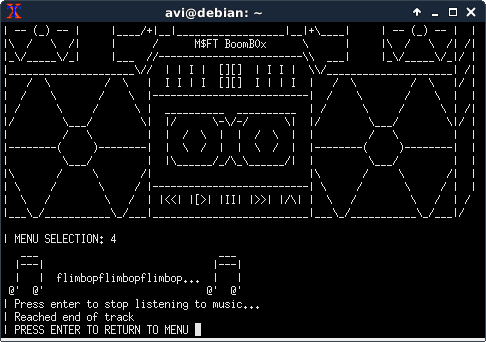
It also allows recording over the data at the current position of the tape, using the phenome representation as input.

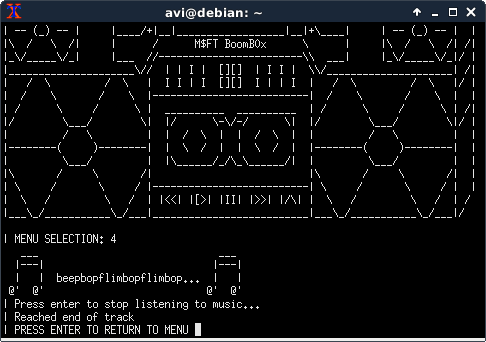
There are also a number of management options:
- Ejecting (deleting) a tape
- Switching to another already-uploaded tape
- Fastforwarding/rewinding the current track
- Going to the next/previous track on the current tape
- Seeking to a bytewise offset on the current track

Finding the vulnerability
My first thought was that the vulnerability would be a UAF, so I started off by reversing the upload/eject codepaths, which conveniently also involved discovering details of the data structures that boombox uses.
Sadly, all the input seemed to be handled cleanly in upload, and everything is freed and nulled correctly in eject.
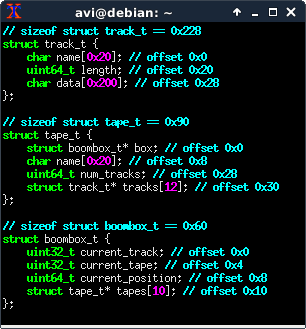
The next place I looked was seek, to see if it had bounds checks (which it did).
The next obvious place for a vulnerability to be would be in record/play, as those are string handling functions.
play delegates to render_music, and record to record_aux.
Both helper functions take a length parameter, and both of them are passed something like track->length - boombox->current_position, which is only correct if you can never go past the end of a track, since the helpers use their length parameter unsignededly.
With the goal of finding a way to trigger an integer overflow in record, I looked at fast_forward, and found that it does a gimmicky calculation involving milliseconds until the enter key is pressed.

Note the difference between 4*(ticks/1000) and (4*ticks)/1000.
Due to integer truncation, if ticks is 1500, the former evaluates as (4*(1500/1000) -> 4*1 -> 4), while the latter evaluates as ((4*1500)/1000 -> 6000/1000 -> 6).
(This is similar in spirit to a class of vulnerabilities called Time-of-Check vs. Time-of-Use, or ToC/ToU for short.)
Since ticks is attacker-controlled (it’s how long we wait to send a newline after), this means that it’s possible to set the current position in the track to 2 past the end of the track.
This then results in -2 being passed as a size to record_aux, being treated as obscenely large (integer overflow), and allowing a heap smash.
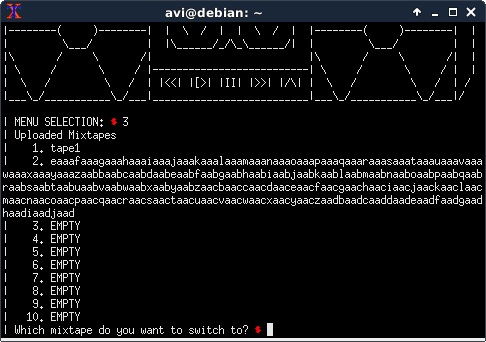
Exploiting the vulnerability
There’s a convenient print_flag function in boombox.exe, so the only thing needed to win is control of the instruction pointer and a .text segment address (assuming ASLR is on).

There’s a boombox_t struct on the stack, and an attacker-influenced layout of tape_t and track_t on the heap.
My exploit:
- Creates a tape with 2 tracks, and a tape with 1 track after it.
At this point, the heap layout istape1 | track1 | track2 | tape2 | track3
tape1’s tracks array has pointers totrack1andtrack2, andtape2’s has a pointer totrack3 - Seeks to near the end of the
track1, and triggers thefast_forwardToC/ToU bug. - Uses
recordas a heap smash to set thetrack2length to be 1024 (increased from 512)
The reason not to set it to something extreme like2**64-1is thatplaydoes a loop that reads up to the track’s length (although it doesn’t overflow the rendering buffer), and it needs to be practical to read the content of heap to find out where the stack is. - Using
track2, reads theboxpointer fromtape2(it’s set inupload_mixtape, but never used anywhere, so it’s probably deliberate for exactly this purpose). - Uses
track2to overwrite thetape2->tracks[0]to point at an offset into the boombox so thattape2->tracks[0]->lengthoverlaps with the boombox’s pointer to the second tape. This orphanstrack3.
As per the comment in step 3, this won’t allow reading the stack, but it does allow controlled writes on the stack. - Uses the
tape2->tracks[0]to create a “reasonable” length field after the boombox’s tapes (overwriting something on the stack that’s probably not important).
It can’t be created inside the boombox’s tapes array, since that would result in a segfault when it tries to find the name of a tape using the length field as a pointer inselect_mixtape. - Uses
track2to overwrite thetape2->tracks[0]to use the “reasonable” length field on the stack created in step 6. - Uses
tape2->tracks[0]to read main’s return address, bypassing ASLR. - Uses
tape2->tracks[0]to overwrite main’s return address to point at an offset intoprint_flag.
When I tried pointing it atprint_flagdirectly, it segfaulted and didn’t print out the flag. At first, I had thought that I had used the wrong original address in the ASLR calculation, but when I tried usingprint_boomboxandprint_menu, those worked correctly. I tried skippingprint_flag’s stack cookie initialization (by usingprint_flag+0x1b) on the hunch that “maybe it’s writing to the stack wrongly somehow”, and it printed out the flag before segfaulting.
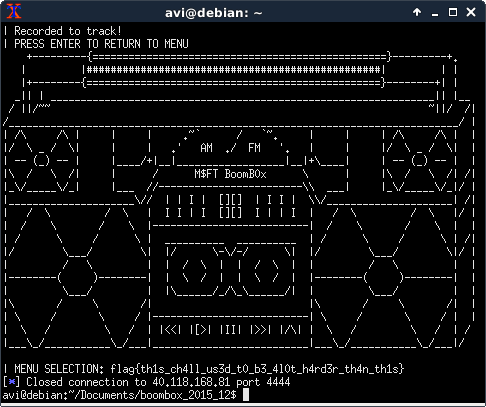
Disclaimer
I wasn’t fast enough to solve this during CSAW Finals. The challenge’s author sent it to the RPISEC mailing list over winter break, soliciting writeups for it.